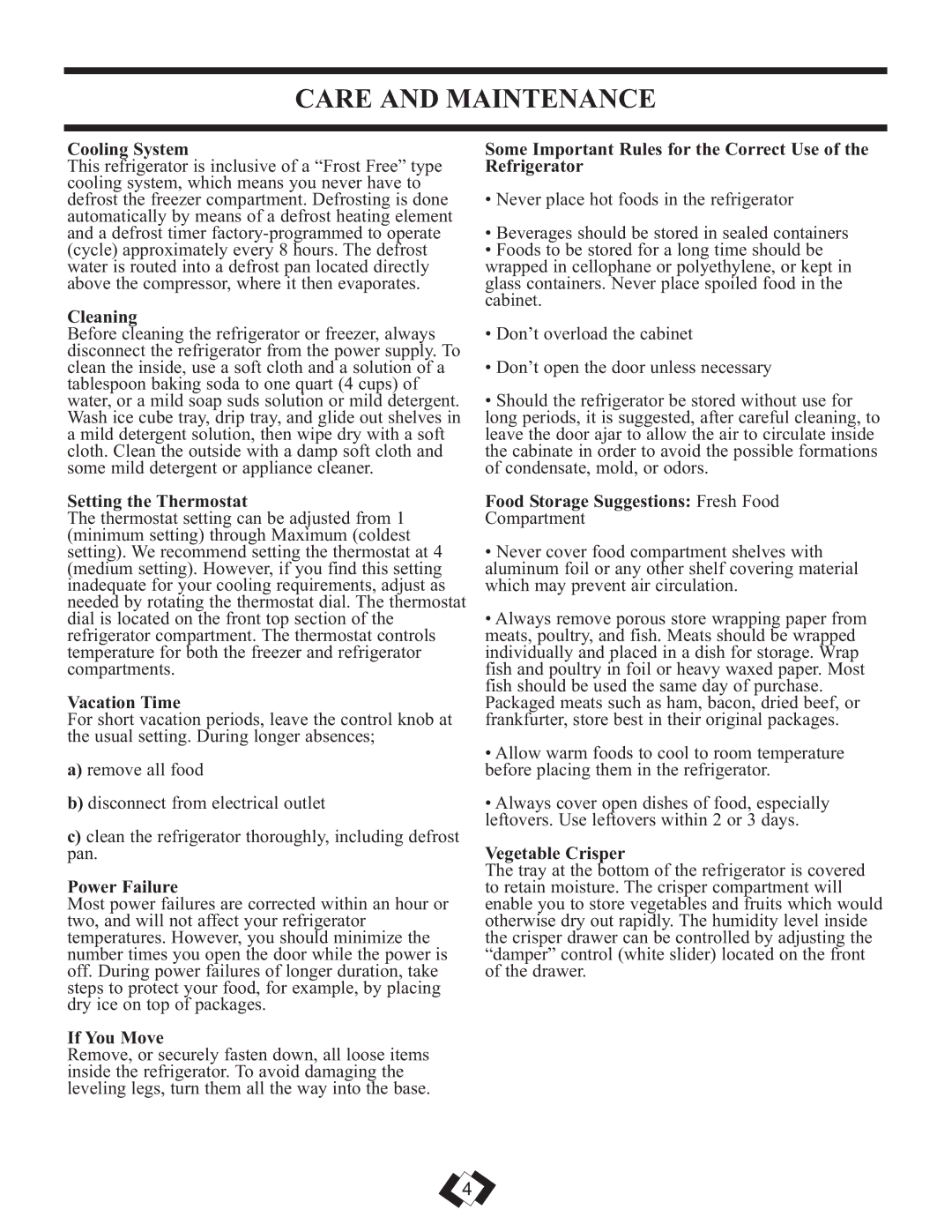
CARE AND MAINTENANCE
Cooling System
This refrigerator is inclusive of a “Frost Free” type cooling system, which means you never have to defrost the freezer compartment. Defrosting is done automatically by means of a defrost heating element and a defrost timer
Cleaning
Before cleaning the refrigerator or freezer, always disconnect the refrigerator from the power supply. To clean the inside, use a soft cloth and a solution of a tablespoon baking soda to one quart (4 cups) of water, or a mild soap suds solution or mild detergent. Wash ice cube tray, drip tray, and glide out shelves in a mild detergent solution, then wipe dry with a soft cloth. Clean the outside with a damp soft cloth and some mild detergent or appliance cleaner.
Setting the Thermostat
The thermostat setting can be adjusted from 1 (minimum setting) through Maximum (coldest setting). We recommend setting the thermostat at 4 (medium setting). However, if you find this setting inadequate for your cooling requirements, adjust as needed by rotating the thermostat dial. The thermostat dial is located on the front top section of the refrigerator compartment. The thermostat controls temperature for both the freezer and refrigerator compartments.
Vacation Time
For short vacation periods, leave the control knob at the usual setting. During longer absences;
a)remove all food
b)disconnect from electrical outlet
c)clean the refrigerator thoroughly, including defrost pan.
Power Failure
Most power failures are corrected within an hour or two, and will not affect your refrigerator temperatures. However, you should minimize the number times you open the door while the power is off. During power failures of longer duration, take steps to protect your food, for example, by placing dry ice on top of packages.
If You Move
Remove, or securely fasten down, all loose items inside the refrigerator. To avoid damaging the leveling legs, turn them all the way into the base.
Some Important Rules for the Correct Use of the Refrigerator
•Never place hot foods in the refrigerator
•Beverages should be stored in sealed containers
•Foods to be stored for a long time should be wrapped in cellophane or polyethylene, or kept in glass containers. Never place spoiled food in the cabinet.
•Don’t overload the cabinet
•Don’t open the door unless necessary
•Should the refrigerator be stored without use for long periods, it is suggested, after careful cleaning, to leave the door ajar to allow the air to circulate inside the cabinate in order to avoid the possible formations of condensate, mold, or odors.
Food Storage Suggestions: Fresh Food
Compartment
•Never cover food compartment shelves with aluminum foil or any other shelf covering material which may prevent air circulation.
•Always remove porous store wrapping paper from meats, poultry, and fish. Meats should be wrapped individually and placed in a dish for storage. Wrap fish and poultry in foil or heavy waxed paper. Most fish should be used the same day of purchase.
Packaged meats such as ham, bacon, dried beef, or frankfurter, store best in their original packages.
•Allow warm foods to cool to room temperature before placing them in the refrigerator.
•Always cover open dishes of food, especially leftovers. Use leftovers within 2 or 3 days.
Vegetable Crisper
The tray at the bottom of the refrigerator is covered to retain moisture. The crisper compartment will enable you to store vegetables and fruits which would otherwise dry out rapidly. The humidity level inside the crisper drawer can be controlled by adjusting the “damper” control (white slider) located on the front of the drawer.
4
